The document discusses the shortest path problem in graphs, focusing on methods to efficiently find the shortest routes between nodes using algorithms such as Dijkstra's and Floyd's algorithm. It describes various forms of the shortest path problem, including single-source and all-pairs shortest path scenarios, and provides detailed explanations of the algorithms, their operations, and complexities. Additionally, the document includes steps to recover paths and implement the algorithms using weight matrices.

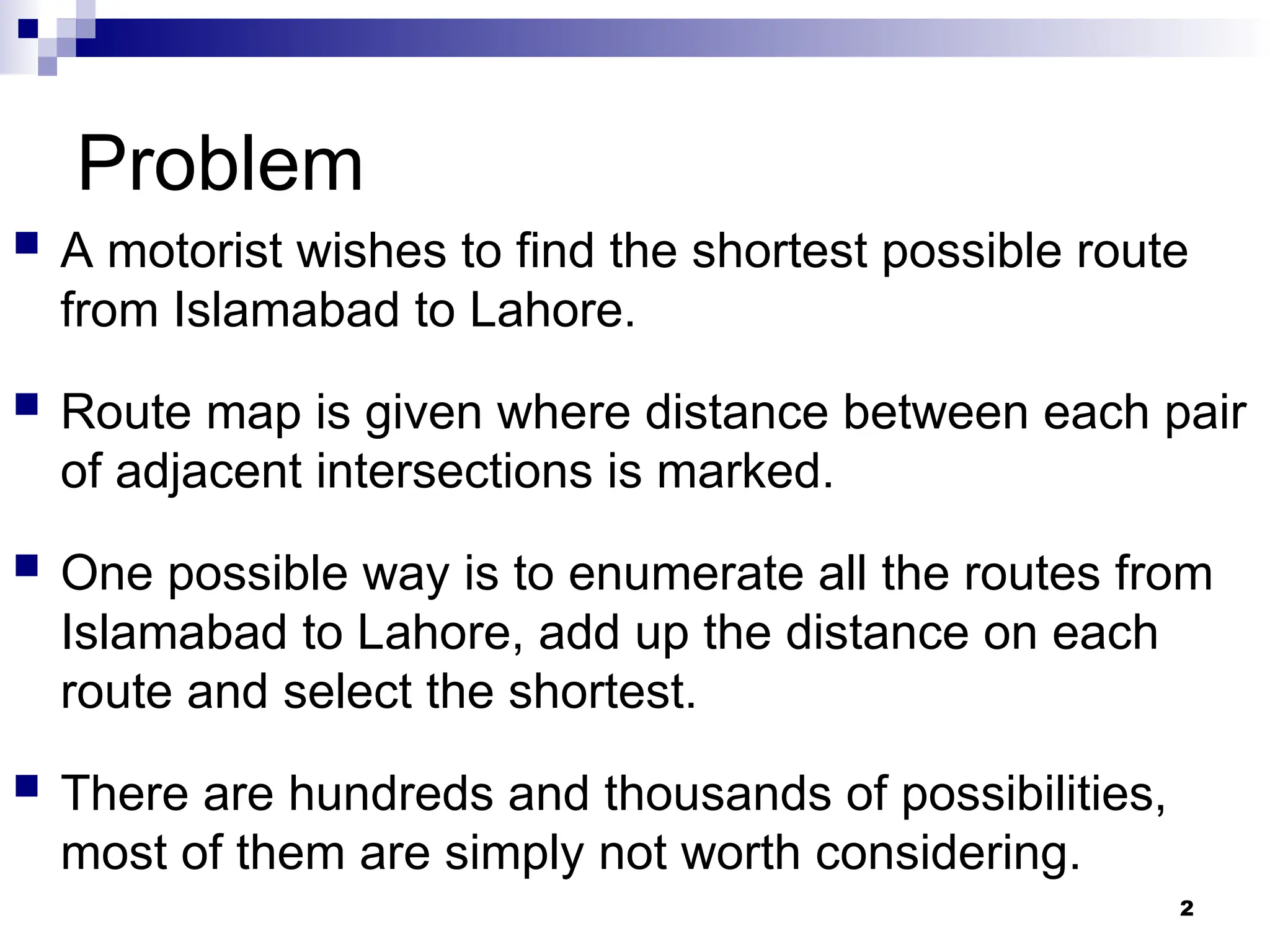

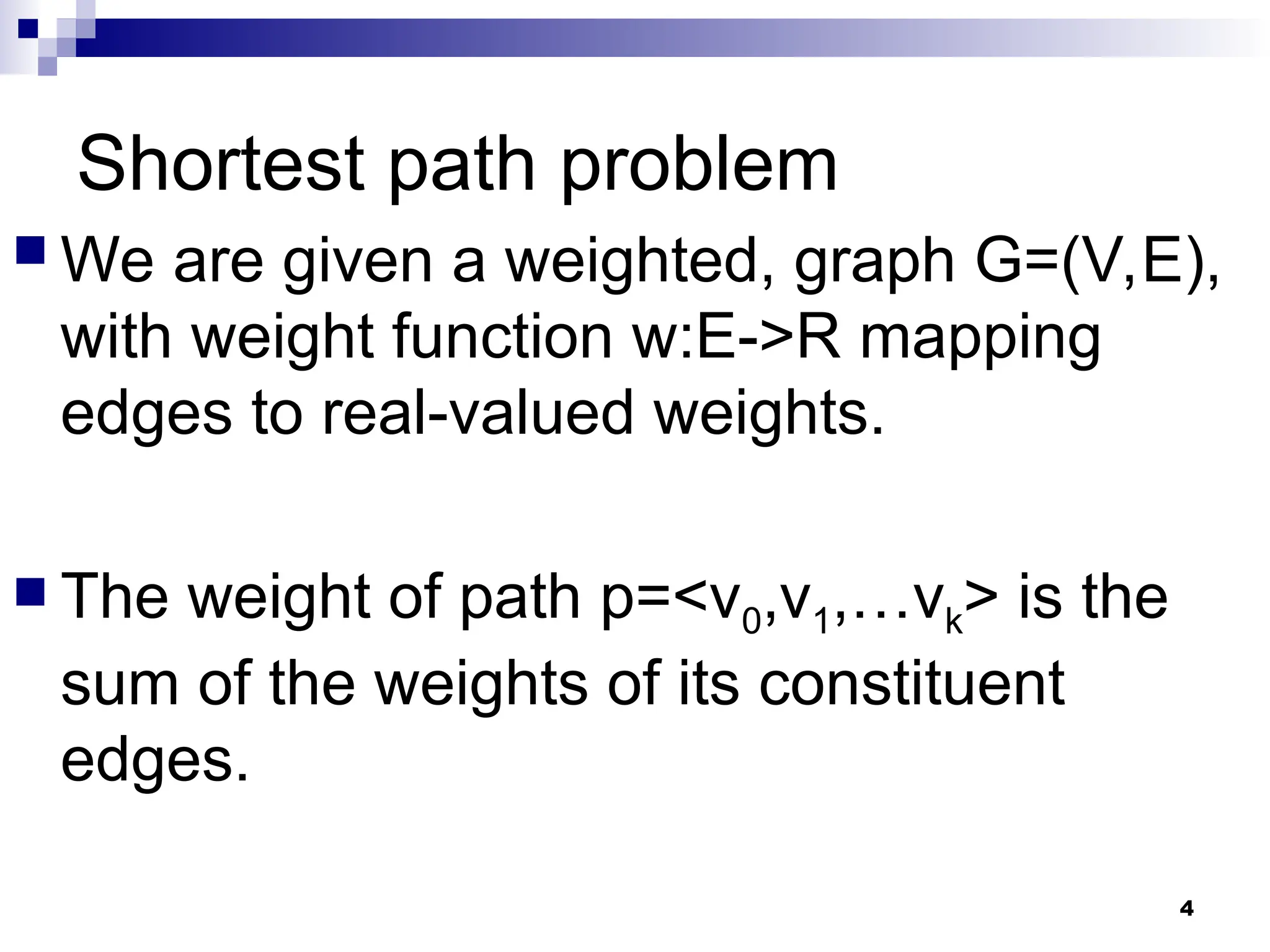
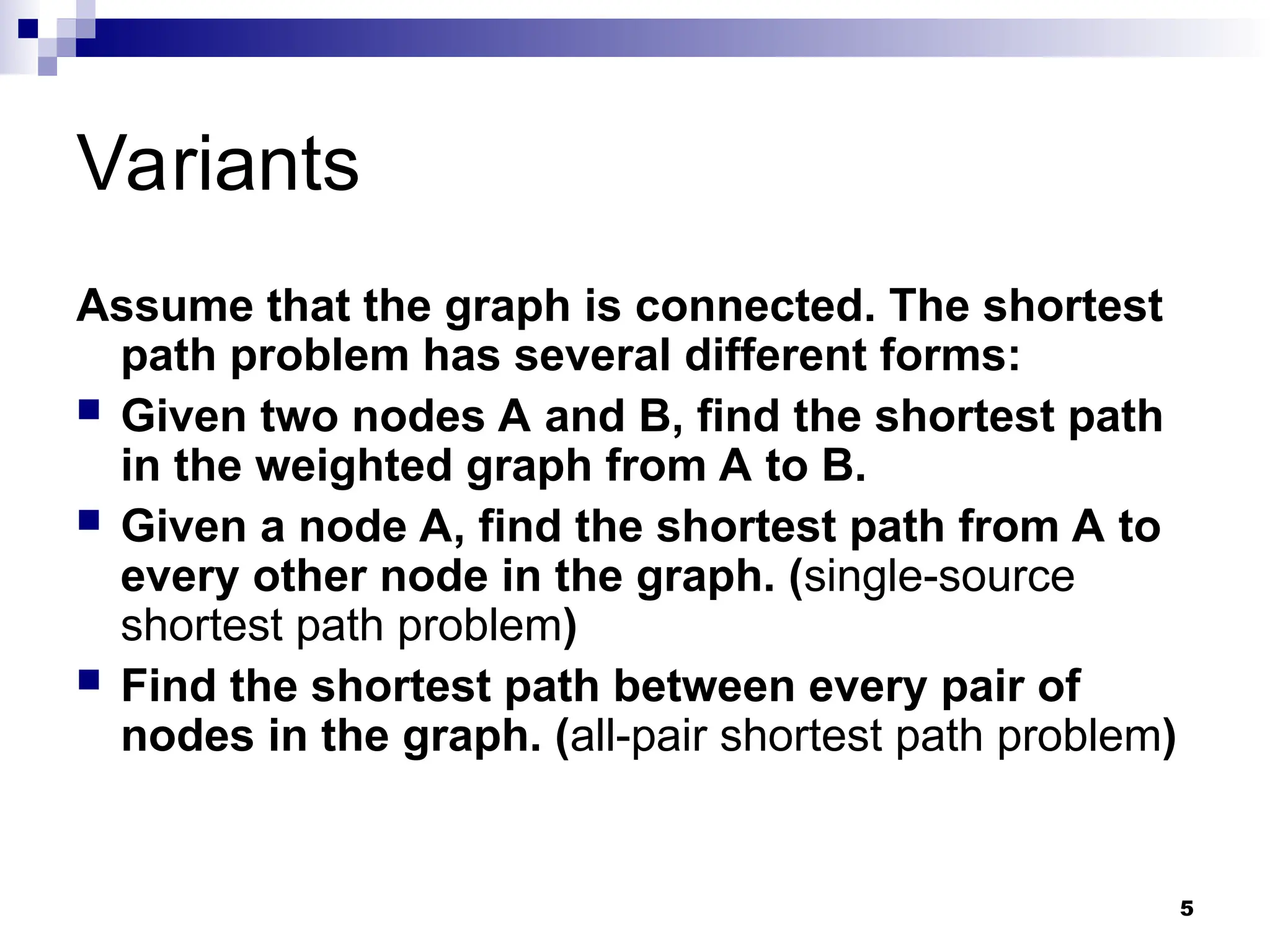
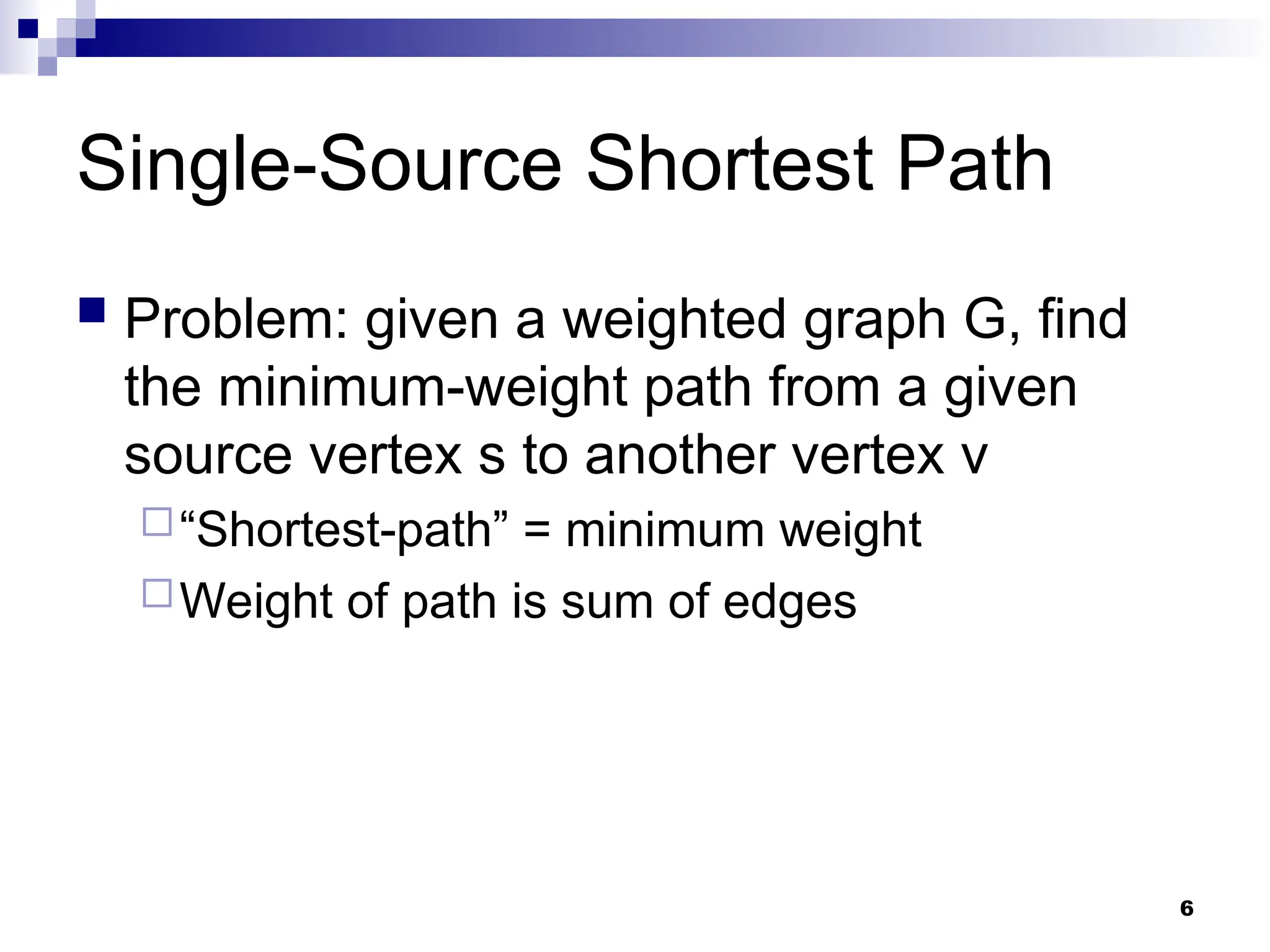
![Dijkstra’s Algorithm
Similar to breadth-first search
Grow a tree gradually, advancing from vertices
taken from a queue
Also similar to Prim’s algorithm for MST
Use a priority queue keyed on d[v]
7](https://image.slidesharecdn.com/lec-35graph-copy8-250105174641-d849c52d/75/Lec-35Graph-Graph-Copy-in-Data-Structure-7-2048.jpg)
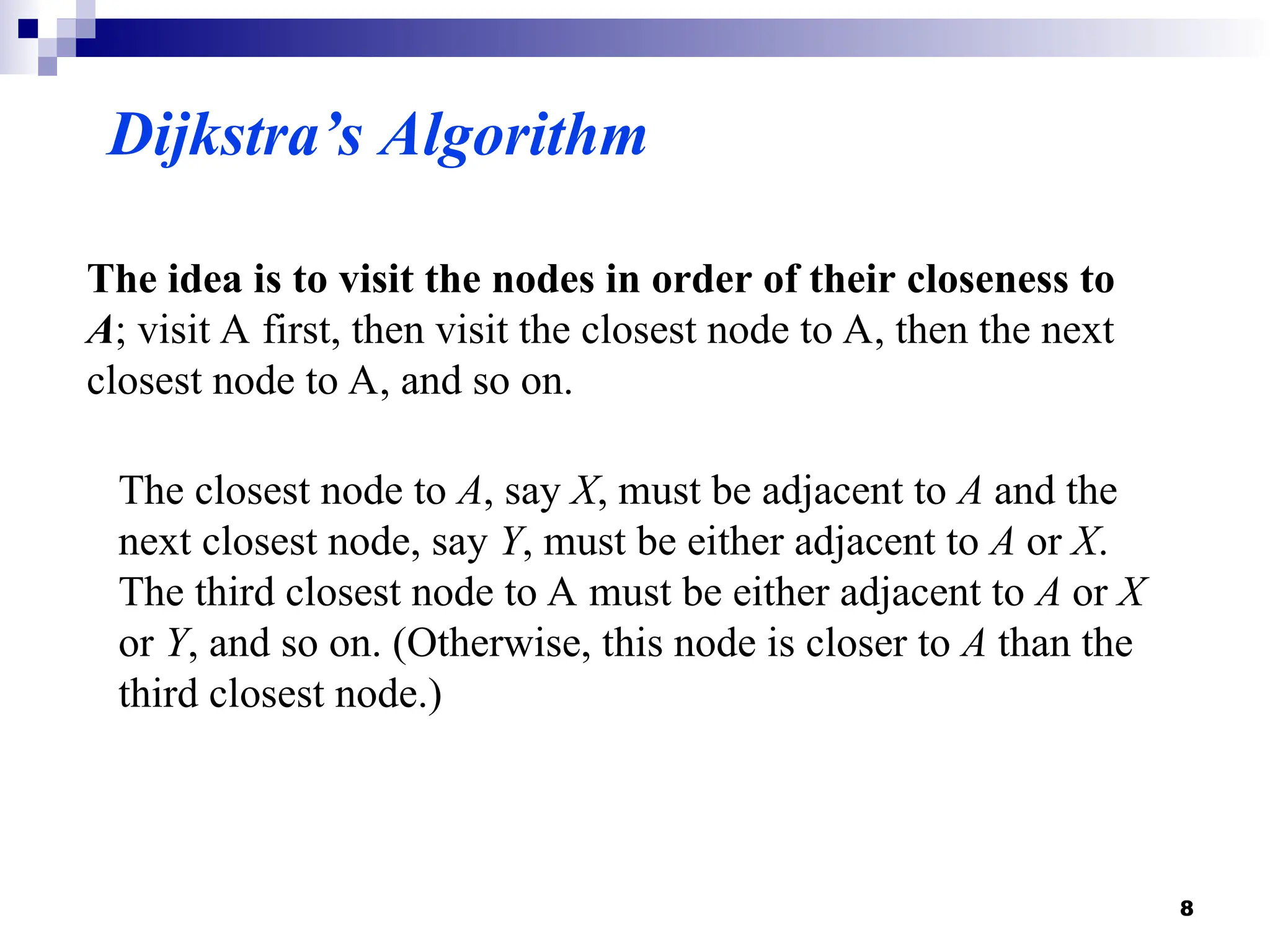
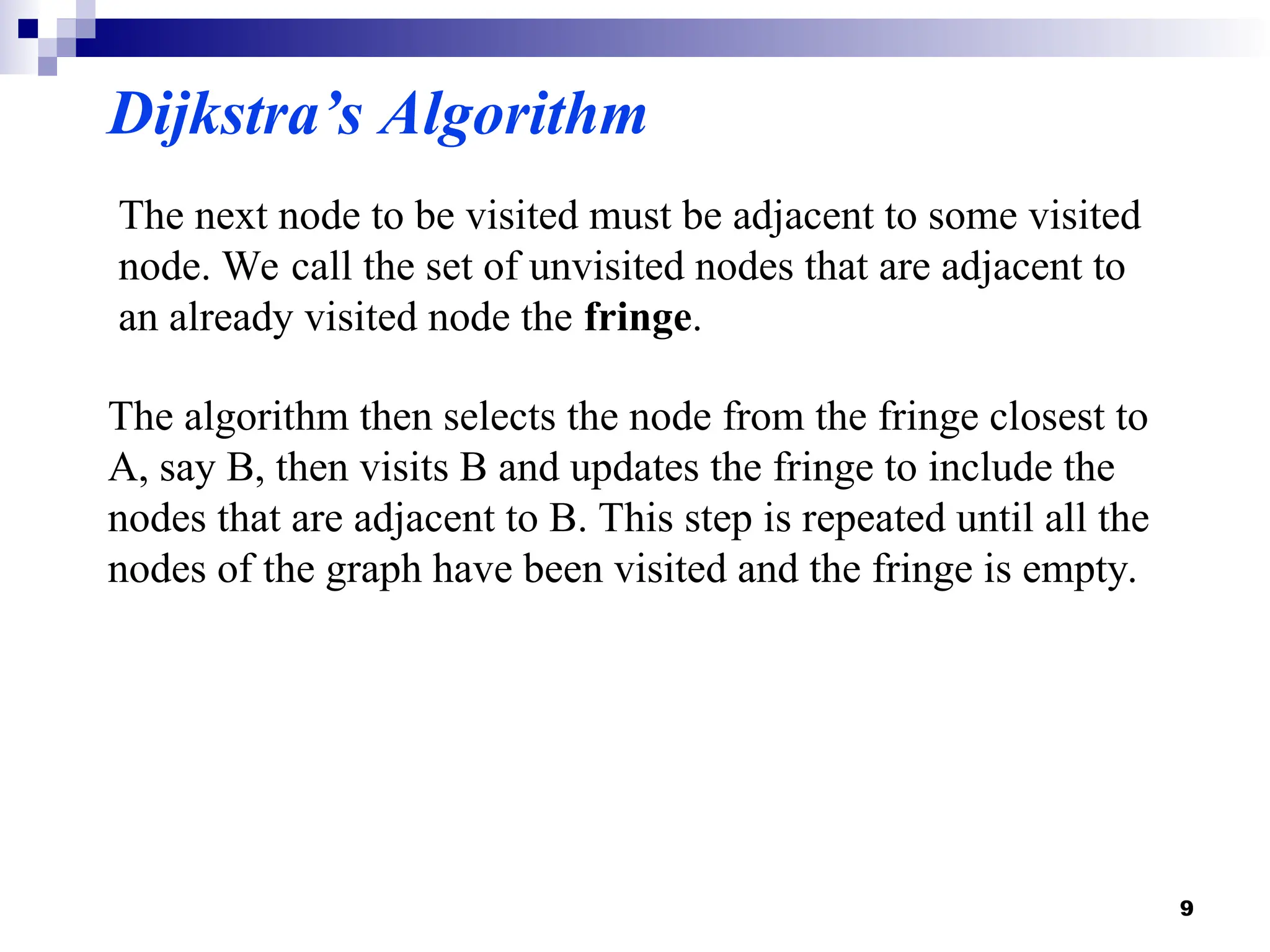
![Dijkstra’s Algorithm
Dijkstra(G)
for each v V
d[v] = ;
d[s] = 0; S = ; Q = V;
while (Q )
u = ExtractMin(Q);
S = S U {u};
for each v u->Adj[]
if (d[v] > d[u]+w(u,v))
d[v] = d[u]+w(u,v);
Relaxation
Step
Note: this
is really a
call to Q->DecreaseKey() 10](https://image.slidesharecdn.com/lec-35graph-copy8-250105174641-d849c52d/75/Lec-35Graph-Graph-Copy-in-Data-Structure-10-2048.jpg)
![Dijkstra’s Algorithm
Dijkstra(G)
for each v V
d[v] = ;
d[s] = 0; S = ; Q = V;
while (Q )
u = ExtractMin(Q);
S = S U {u};
for each v u->Adj[]
if (d[v] > d[u]+w(u,v))
d[v] = d[u]+w(u,v);
How many times is
ExtractMin() called?
How many times is
DecreaseKey() called?
What will be the total running time? 11](https://image.slidesharecdn.com/lec-35graph-copy8-250105174641-d849c52d/75/Lec-35Graph-Graph-Copy-in-Data-Structure-11-2048.jpg)
![Dijkstra’s Algorithm
Dijkstra(G)
for each v V
d[v] = ;
d[s] = 0; S = ; Q = V;
while (Q )
u = ExtractMin(Q);
S = S U {u};
for each v u->Adj[]
if (d[v] > d[u]+w(u,v))
d[v] = d[u]+w(u,v);
How many times is
ExtractMin() called?
How many times is
DecreaseKey() called?
A: O(E log V) using binary heap for Q 12](https://image.slidesharecdn.com/lec-35graph-copy8-250105174641-d849c52d/75/Lec-35Graph-Graph-Copy-in-Data-Structure-12-2048.jpg)
![Step by Step operation of Dijkstra
algorithm
Step1. Given initial graph G=(V, E). All nodes have infinite cost
except the source node, s, which has 0 cost.
Step 2. First we choose the node, which is closest to the source node, s. We
initialize d[s] to 0. Add it to S. Relax all nodes adjacent to source, s. Update
predecessor (see red arrow in diagram below) for all nodes updated.
13](https://image.slidesharecdn.com/lec-35graph-copy8-250105174641-d849c52d/75/Lec-35Graph-Graph-Copy-in-Data-Structure-13-2048.jpg)
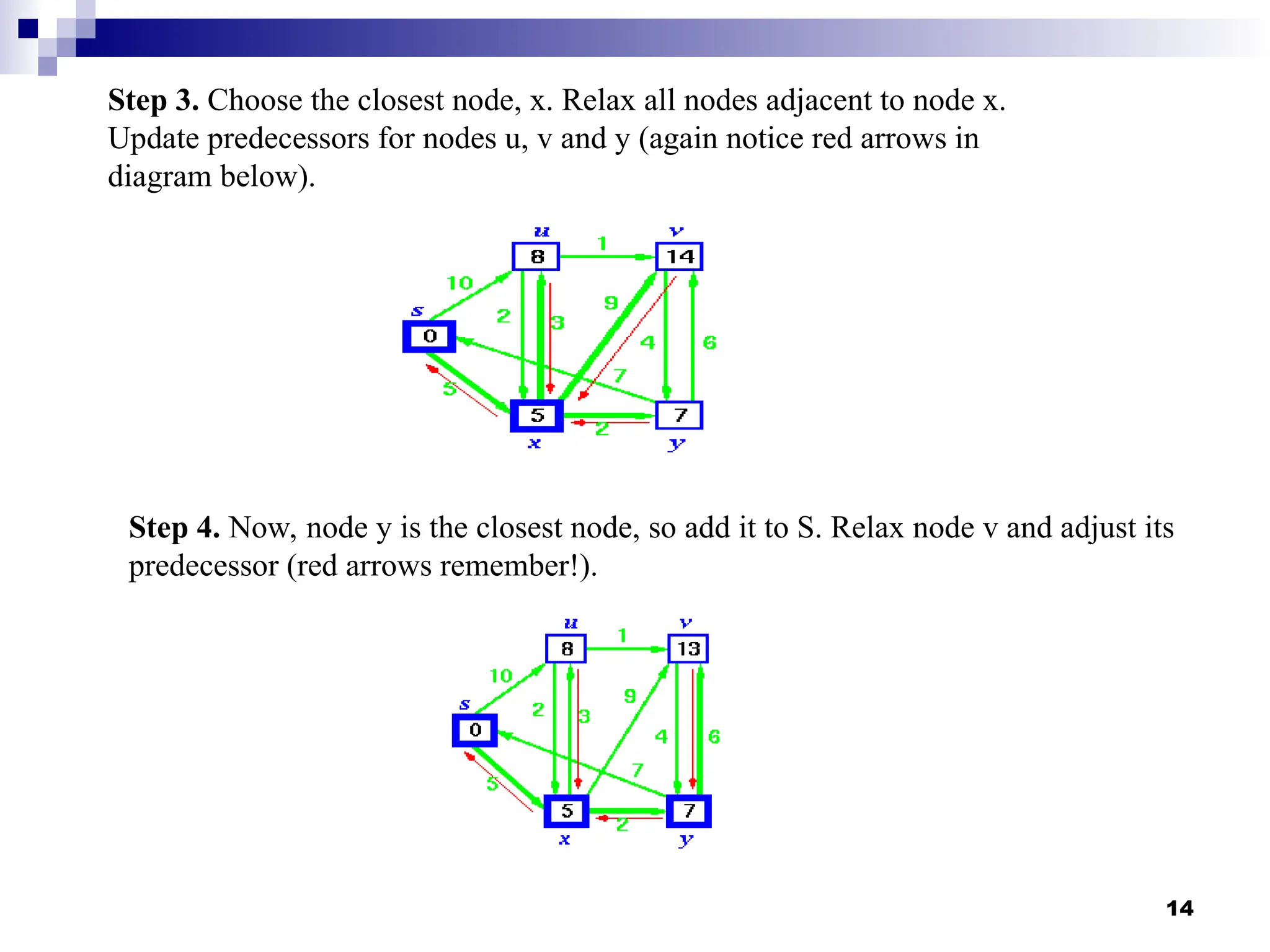
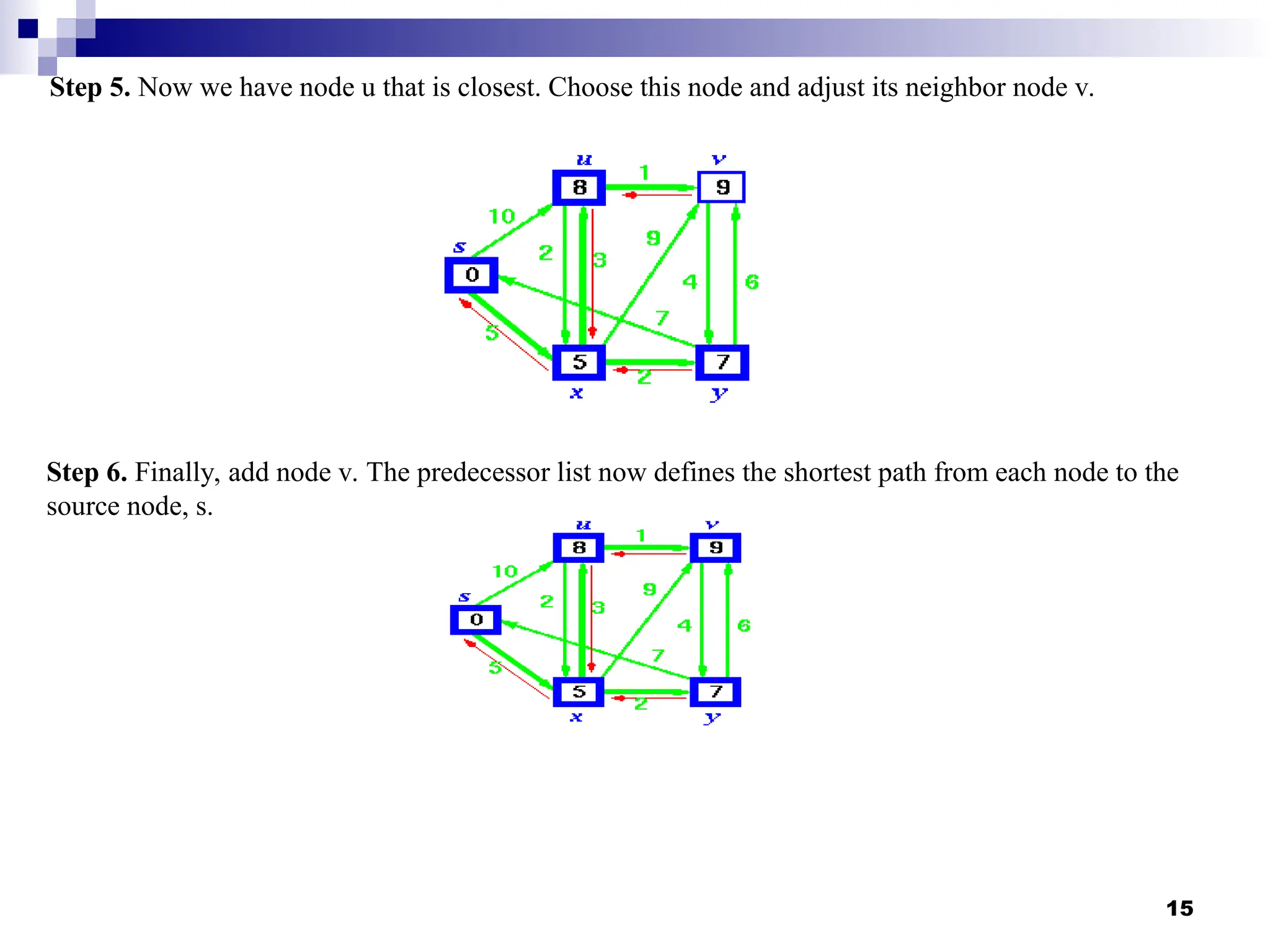
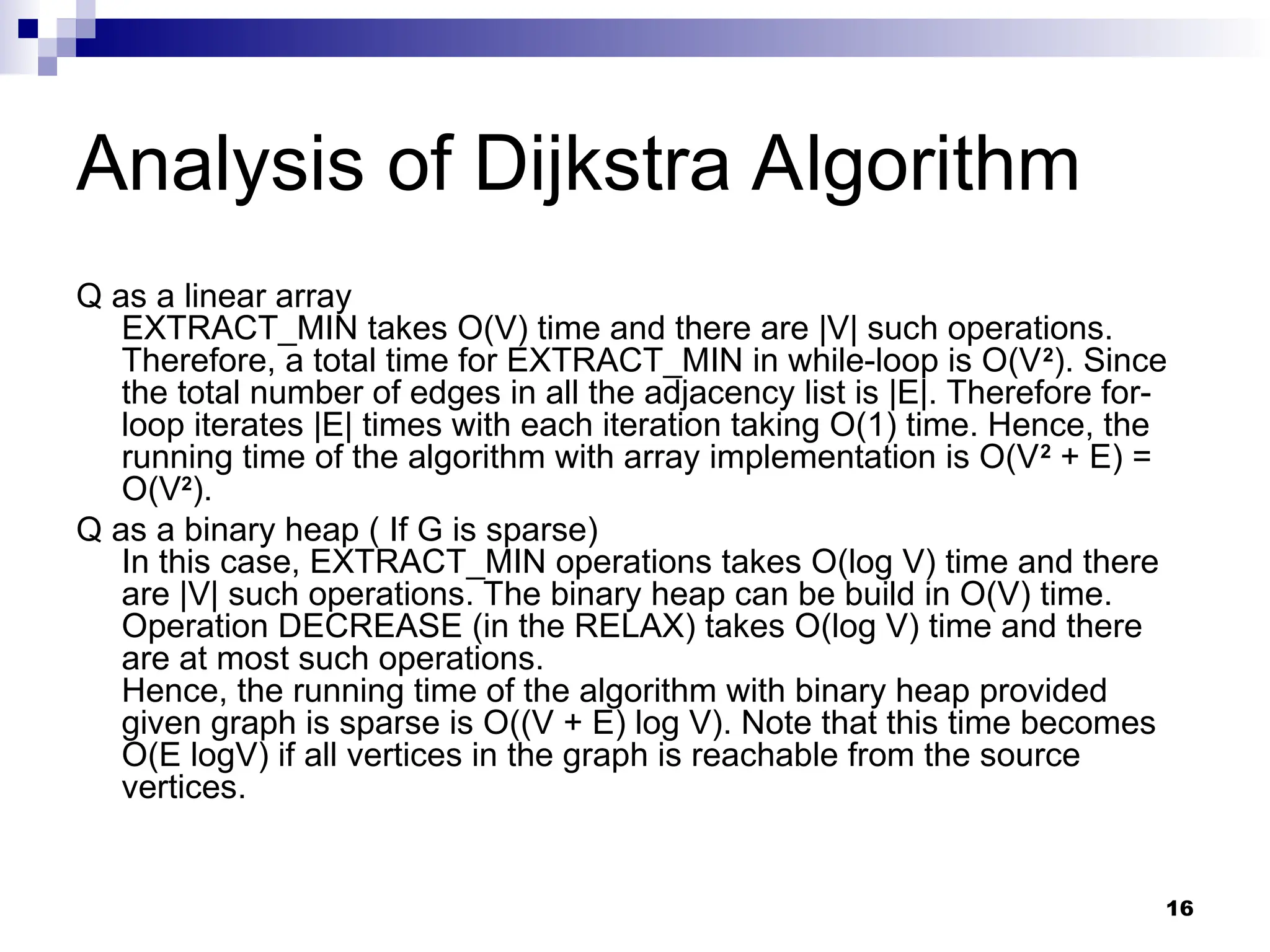
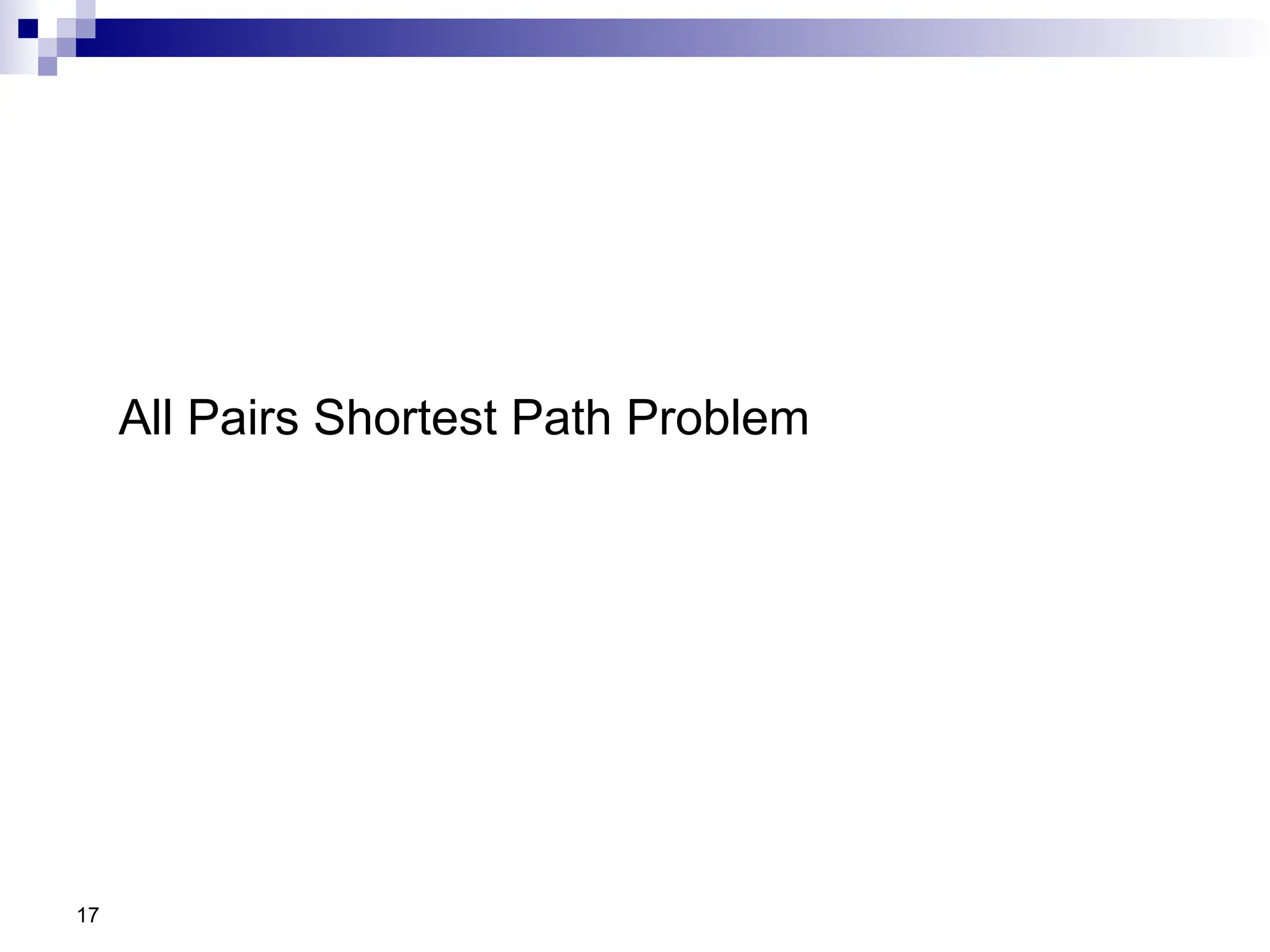
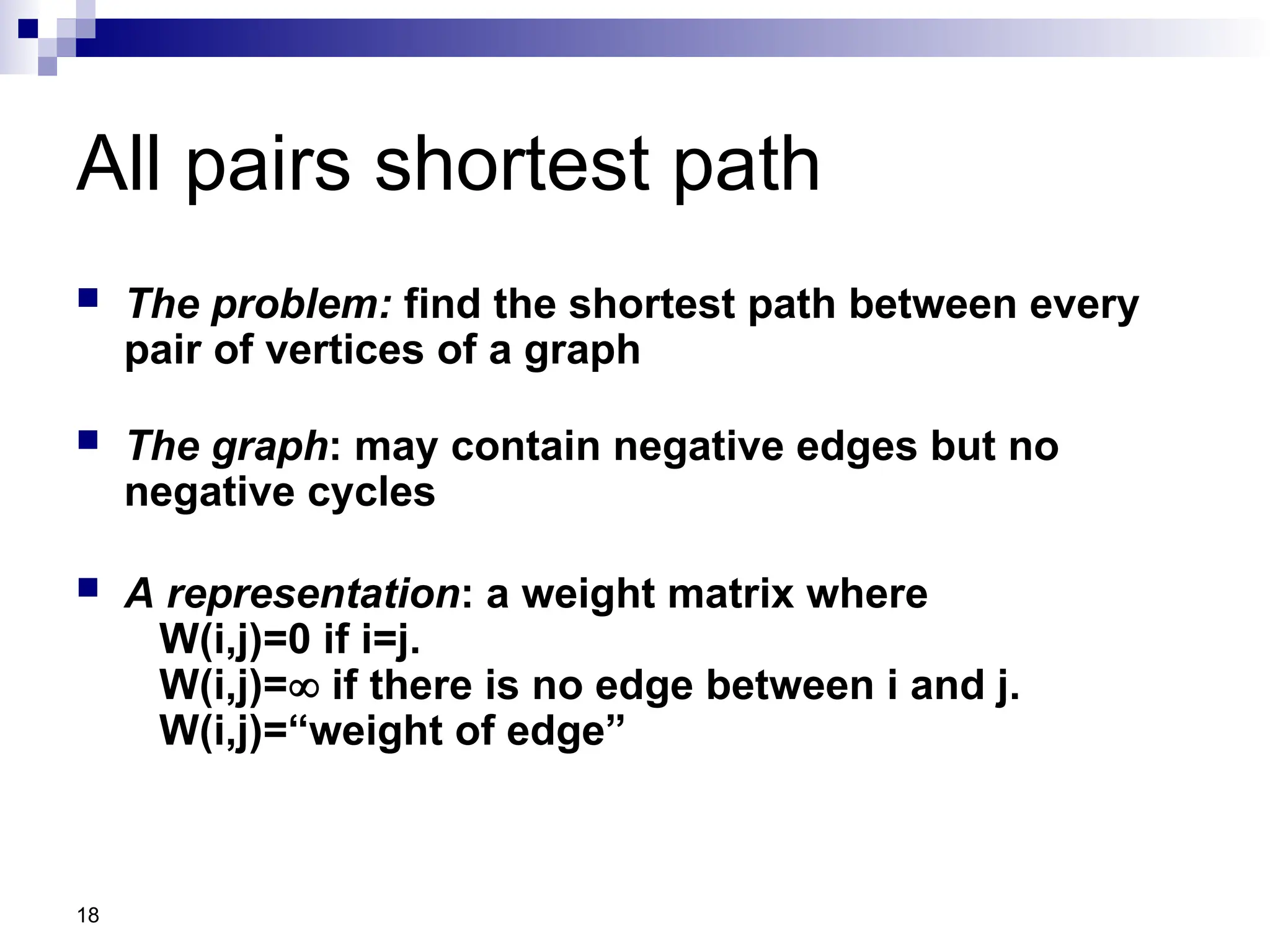
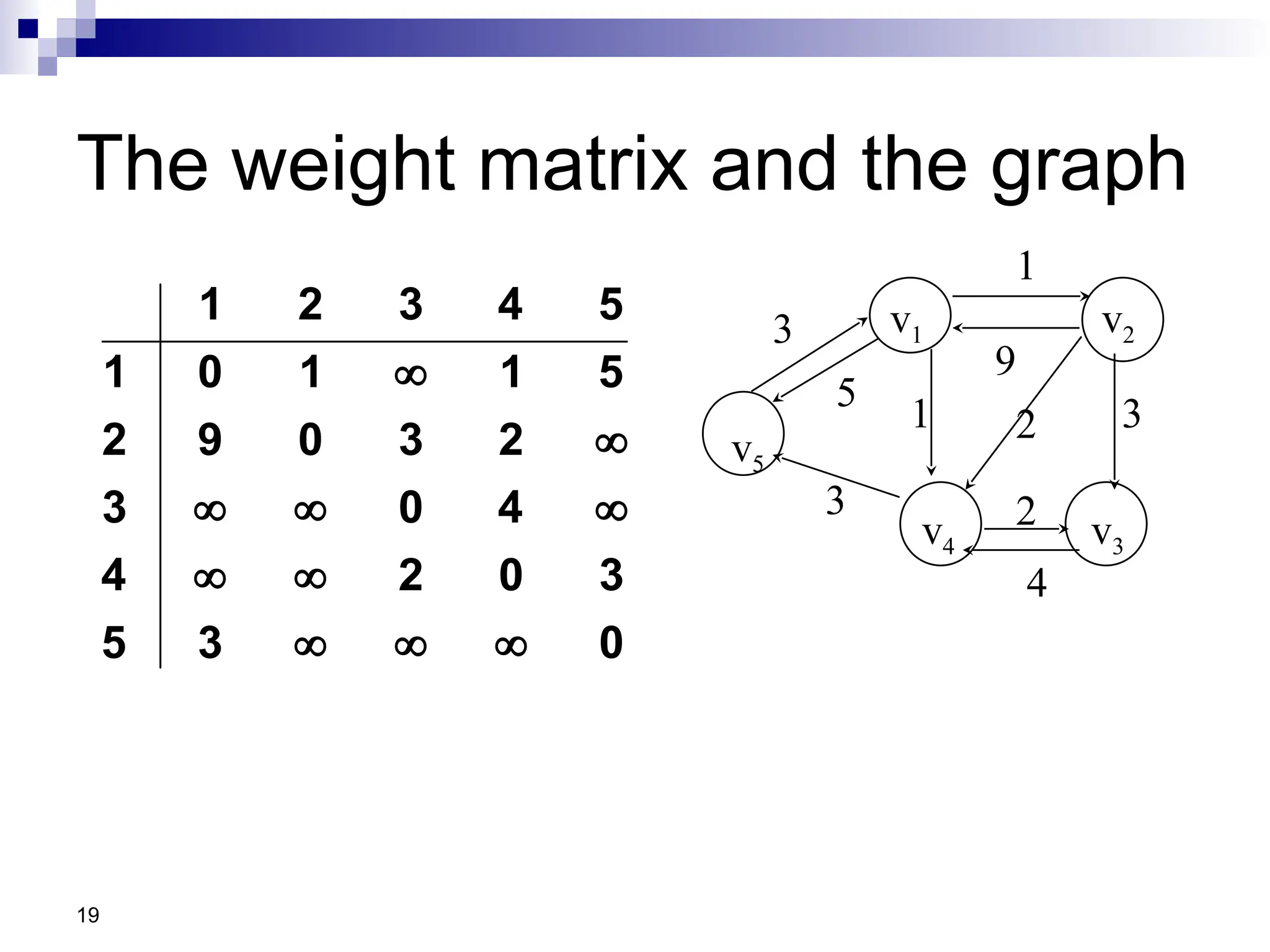
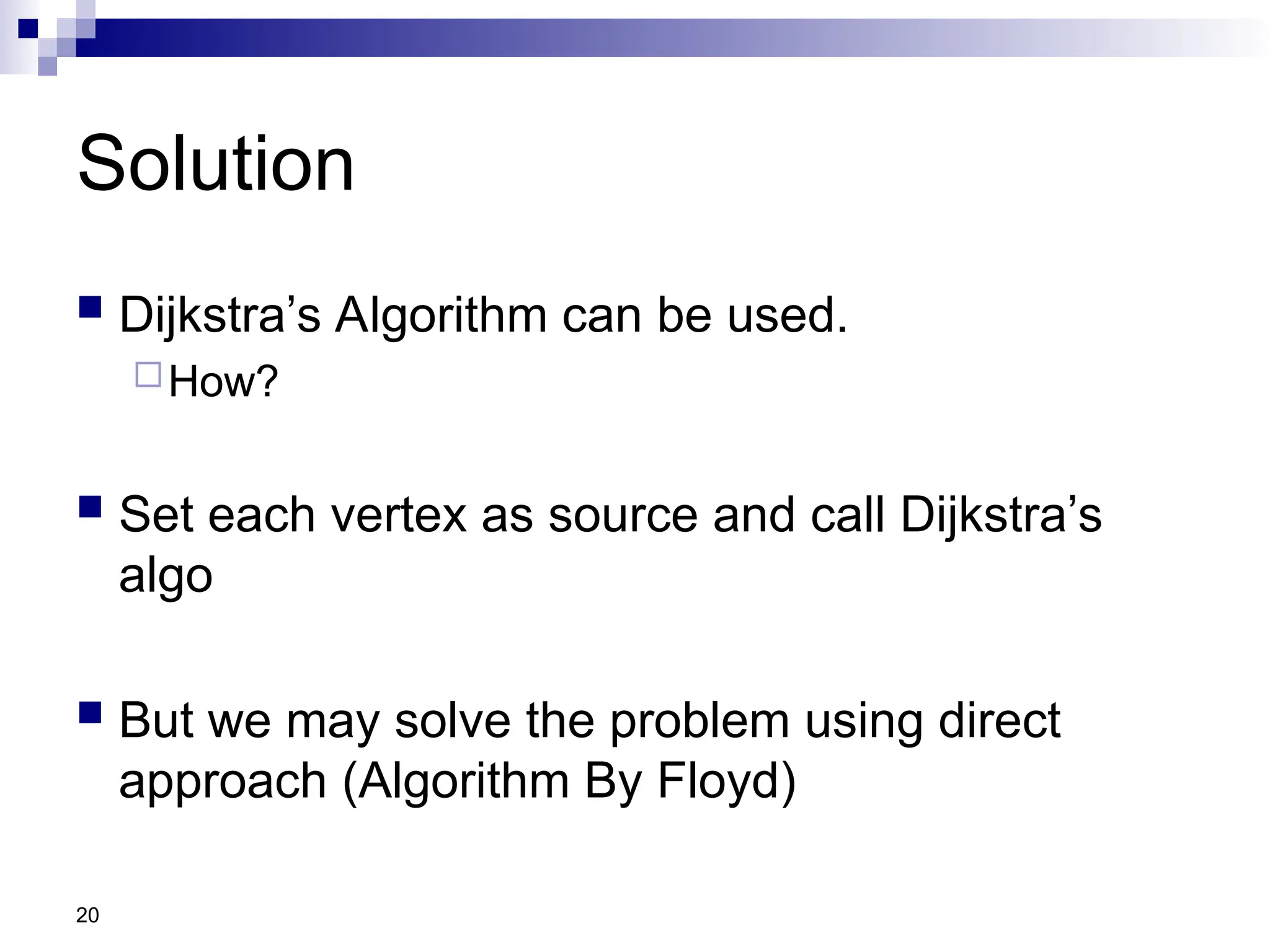
![21
Floyd’s Algo
Assume vertices are numbered as 1,2,3,…n for
simplicity
Uses n×n matrix D (n is the number of vertices
in the graph G)
Shortest paths are computed in matrix D
After running the algorithm D[i,j] contains the
shortest distance (cost) between vertices i and j](https://image.slidesharecdn.com/lec-35graph-copy8-250105174641-d849c52d/75/Lec-35Graph-Graph-Copy-in-Data-Structure-21-2048.jpg)
![22
Floyd’s Algo
Initially we set D[i,j]=W[i,j]
Remember
W[i,j]=0 if i==j
W(i,j)=∞ if there is no edge between i and j
W(i,j)=“weight of edge”
We make n iteration over matrix D
After kth iteration D[i,j] will store the value
of minimum weight path from vertex i to
vertex j that does not pass through a
vertex numbered higher than k](https://image.slidesharecdn.com/lec-35graph-copy8-250105174641-d849c52d/75/Lec-35Graph-Graph-Copy-in-Data-Structure-22-2048.jpg)
![23
Floyd’s Algo
In kth iteration we use following formula to compute D
]
,
[
]
,
[
]
,
[
min
]
,
[
1
1
1
j
k
D
k
i
D
j
i
D
j
i
D
k
k
k
k
● Subscript k denotes the value of matrix D after the kth
iteration (It should not be assumed there are n different
matrices of size n×n)](https://image.slidesharecdn.com/lec-35graph-copy8-250105174641-d849c52d/75/Lec-35Graph-Graph-Copy-in-Data-Structure-23-2048.jpg)
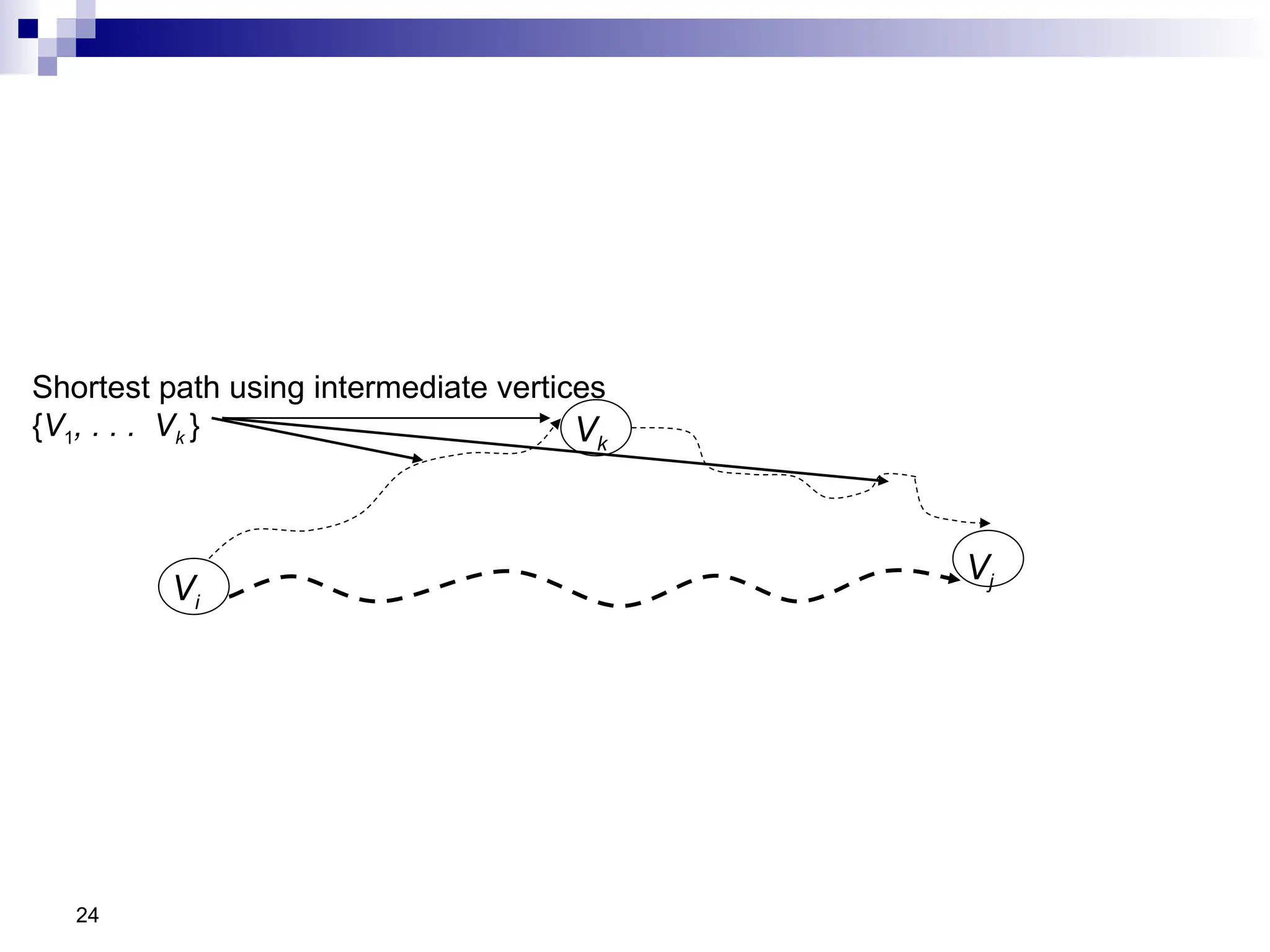
![25
Floyed’s Algorithm
Floyd
1. D W // initialize D array to W [ ]
2.
3. for k 1 to n
4. do for i 1 to n
5. do for j 1 to n
6. if (D[ i, j ] > D[ i, k ] + D[ k, j ] )
7. then D[ i, j ] D[ i, k ] + D[ k, j ]](https://image.slidesharecdn.com/lec-35graph-copy8-250105174641-d849c52d/75/Lec-35Graph-Graph-Copy-in-Data-Structure-25-2048.jpg)
![26
Recovering Paths
Use another matrix P
P[i,j] hold the vertex k that led Floyd to find
the smallest value of D[i,j]
If P[i,j]=0 there is no intermediate edge
involved, shortest path is direct edge
between i and j
So modified version of Floyd is given](https://image.slidesharecdn.com/lec-35graph-copy8-250105174641-d849c52d/75/Lec-35Graph-Graph-Copy-in-Data-Structure-26-2048.jpg)
![27
Recovering Paths
Floyd
1. D W // initialize D array to W [ ]
2. P 0
3. for k 1 to n
4. do for i 1 to n
5. do for j 1 to n
6. if (D[ i, j ] > D[ i, k ] + D[ k, j ] )
7. then D[ i, j ] D[ i, k ] + D[ k, j ]
8. P [ i, j] k](https://image.slidesharecdn.com/lec-35graph-copy8-250105174641-d849c52d/75/Lec-35Graph-Graph-Copy-in-Data-Structure-27-2048.jpg)
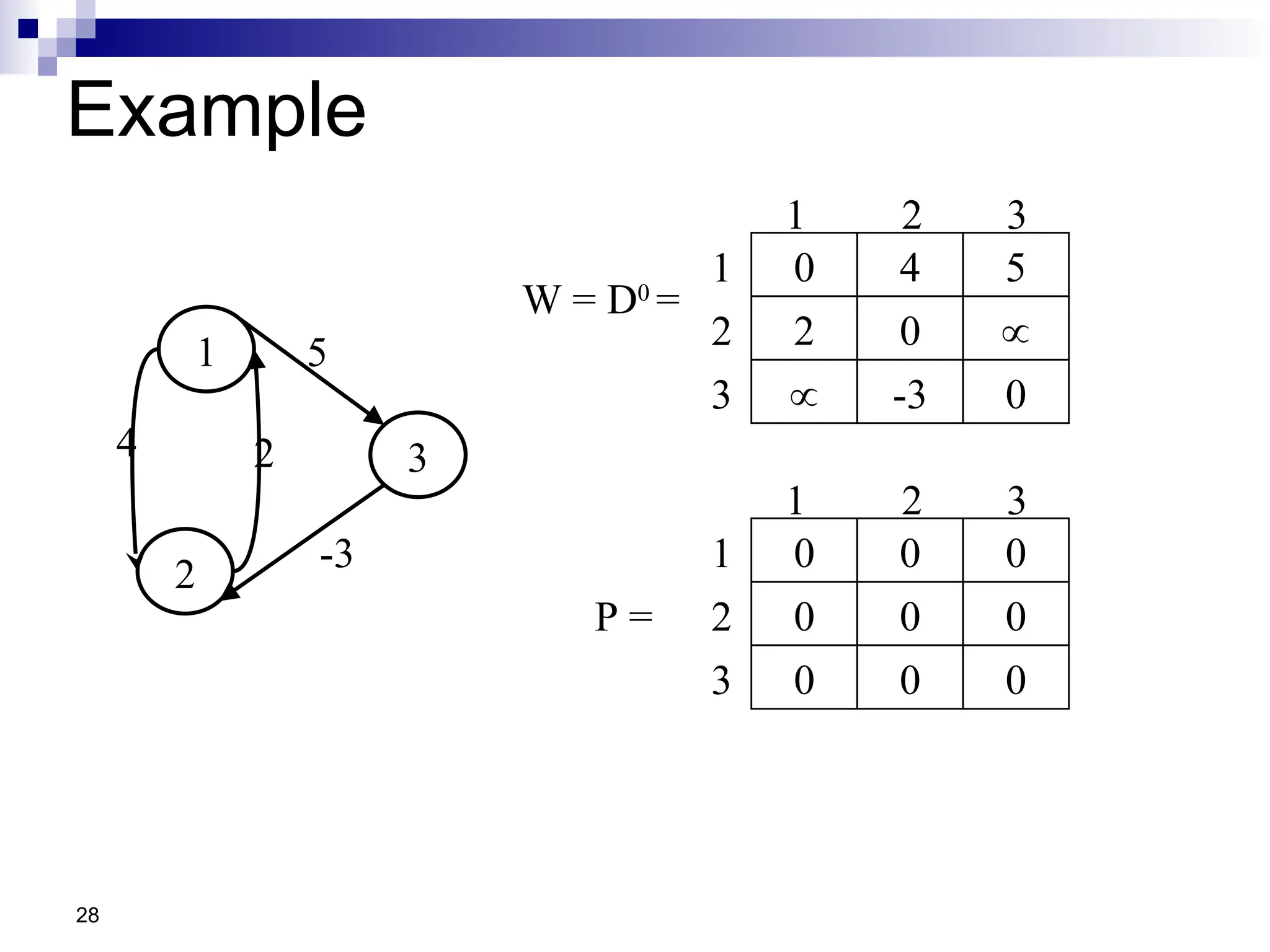
![29
D1
=
4
0 5
2 0 7
-3 0
1 2 3
1
2
3
0
0 0
0 0 1
0 0 0
1 2 3
1
2
3
P =
1
2
3
5
-3
2
4
k = 1
Vertex 1 can be intermediate
node
D1
[2,3] = min( D0
[2,3], D0
[2,1]+D0
[1,3] )
= min (, 7)
= 7
D1
[3,2] = min( D0
[3,2], D0
[3,1]+D0
[1,2] )
= min (-3,)
= -3
4
0 5
2 0
-3 0
1 2 3
1
2
3
D0
=](https://image.slidesharecdn.com/lec-35graph-copy8-250105174641-d849c52d/75/Lec-35Graph-Graph-Copy-in-Data-Structure-29-2048.jpg)
![30
D2
=
4
0 5
2 0 7
-1 -3 0
1 2 3
1
2
3
0
0 0
0 0 1
2 0 0
1 2 3
1
2
3
P =
D2
[1,3] = min( D1
[1,3], D1
[1,2]+D1
[2,3] )
= min (5, 4+7)
= 5
D2
[3,1] = min( D1
[3,1], D1
[3,2]+D1
[2,1] )
= min (, -3+2)
= -1
1
2
3
5
-3
2
4
D1
=
4
0 5
2 0 7
-3 0
1 2 3
1
2
3
k = 2
Vertices 1, 2 can be
intermediate](https://image.slidesharecdn.com/lec-35graph-copy8-250105174641-d849c52d/75/Lec-35Graph-Graph-Copy-in-Data-Structure-30-2048.jpg)
![31
D3
=
2
0 5
2 0 7
-1 -3 0
1 2 3
1
2
3
3
0 0
0 0 1
2 0 0
1 2 3
1
2
3
P =
D3
[1,2] = min(D2
[1,2], D2
[1,3]+D2
[3,2] )
= min (4, 5+(-3))
= 2
D3
[2,1] = min(D2
[2,1], D2
[2,3]+D2
[3,1] )
= min (2, 7+ (-1))
= 2
D2
=
4
0 5
2 0 7
-1 -3 0
1 2 3
1
2
3
1
2
3
5
-3
2
4 k = 3
Vertices 1, 2, 3 can be
intermediate](https://image.slidesharecdn.com/lec-35graph-copy8-250105174641-d849c52d/75/Lec-35Graph-Graph-Copy-in-Data-Structure-31-2048.jpg)
![32
Printing intermediate nodes on
shortest path from i to j
Path (i, j)
k= P[ i, j ];
if (k== 0)
return;
Path (i , k);
print( k);
Path (k, j);
3
0 0
0 0 1
2 0 0
1 2 3
1
2
3
P =
1
2
3
5
-3
2
4](https://image.slidesharecdn.com/lec-35graph-copy8-250105174641-d849c52d/75/Lec-35Graph-Graph-Copy-in-Data-Structure-32-2048.jpg)